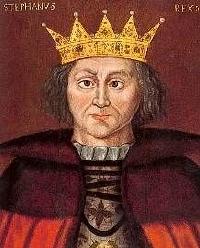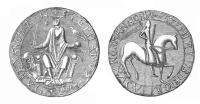Stephen of Blois ~ King of England
M, (between 1095 and 1096 - 25 October 1154)
| Father-Biological* | Stephen III ~ Comte de Blois b. 1046, d. 19 May 1102 |
| Mother-Biological* | Adele of Normandy , Princess of England b. c 1062, d. 8 Mar 1137 |
- Family Lines
- Roy Line
Boudreau Line
Last Edited=24 Jul 2023
Stephen of Blois ~ King of England was born between 1095 and 1096 at Blois, France.1,2,3,4,5,6,7,8,9 He was the son of Stephen III ~ Comte de Blois and Adele of Normandy , Princess of England. Acording to Soud (2017) Stephen was Brave and generous, possessed of the common touch, Stephen of Blois seemed a promising king. But, as his nobles and adversaries soon discovered, he was not cut out for the role. As he lost the control that Henry had secured over England, the country was torn apart by rival forces.8 Stephen became, before 1115, the Comte de Mortain.7,5 In 1120 Stephen narrowly escaped drowning with Henry I's son, William Adelin, in the sinking of the White Ship.9 He and Dameta de Normandie ______ were in a relationship that produced offspring.10 Stephen became, before 1125, the Count of Boulogne in right of his wife.9,5
Stephen of Blois ~ King of England married Matilda ~ Queen of England and Countess of Boulogne, daughter of Eustace III ~ Comte de Boulogne et Lens and Mary ~ Princess of Scotland, in 1125.6,7,3,4,5 Stephen of Blois ~ King of England and an unknown partner were in a relationship that produced offspring. Stephen succeeded his father as the 11th Duke of Normandy in 1135.9,7 He succeeded as King Stephen of England on 1 December 1135 and was crowned King of England by William, Archbishop of Canterbury on 26 December 1135 and styled Rex Aglorum Dux Normannorum. He pretended that the deceased monarch had expressed an intention that he should follow him on the throne, and he was deposed on 10 April 1141. He succeeded again as the King on 1 November 1141 and was crowned as King 25 December 1141 at Canterbury Cathedral, Canterbury, Kent, England. At length, after many changes of fortune, Stephen having lost his son, Eustace, entered into a compact with Henry Plantagenet, son of his rival, the Empress Maud, by which it was agreed that Stephen should enjoy the throne in peace during his life, and that Henry should succeed him.11,3,2,4,5,6,12,7,9 The rightful heiress to the crown of England was Henry I's daughter Matilda but at the time of Henry's death she was with her husband in Anjou and Stephen was the first to reach London and successfully claim the throne. Matilda or Maud, as she was also known, disputed Stephen's claim. Matilda's illegitimate half-brother the 1st Earl of Gloucester rebelled, and civil war broke out in 1139 when Matilda invaded. In April 1141 hostile troops seized Stephen at the Battle of Lincoln but in November exchanged him for Gloucester who had been imprisoned by Stephen's supporters. Stephen then regained much lost power and in 1148 Matilda left England. Upon Maud's death, her son Henry Fitz-Empress continued the challenge. While the dispute continued, Henry married the divorced wife of the French King. This gave him great power as his wife was, in her own right, a reigning Princess. Stephen had married Matilda of Boulogne and hoped that their son Eustace would succeed him, however Eustace died and in 1153 at Winchester, Stephen reluctantly declared Henry Fitz-Empress as his heir.7 He died on 25 October 1154 at Dover Castle, Dover, Kent, England, of a heart attack.1,2,3,4,5,7,8,9 He was buried at Faversham Abbey, Faversham, Kent, England, His tomb was destroyed during the Reformation.7,3,5
See also.
Stephen of Blois ~ King of England married Matilda ~ Queen of England and Countess of Boulogne, daughter of Eustace III ~ Comte de Boulogne et Lens and Mary ~ Princess of Scotland, in 1125.6,7,3,4,5 Stephen of Blois ~ King of England and an unknown partner were in a relationship that produced offspring. Stephen succeeded his father as the 11th Duke of Normandy in 1135.9,7 He succeeded as King Stephen of England on 1 December 1135 and was crowned King of England by William, Archbishop of Canterbury on 26 December 1135 and styled Rex Aglorum Dux Normannorum. He pretended that the deceased monarch had expressed an intention that he should follow him on the throne, and he was deposed on 10 April 1141. He succeeded again as the King on 1 November 1141 and was crowned as King 25 December 1141 at Canterbury Cathedral, Canterbury, Kent, England. At length, after many changes of fortune, Stephen having lost his son, Eustace, entered into a compact with Henry Plantagenet, son of his rival, the Empress Maud, by which it was agreed that Stephen should enjoy the throne in peace during his life, and that Henry should succeed him.11,3,2,4,5,6,12,7,9 The rightful heiress to the crown of England was Henry I's daughter Matilda but at the time of Henry's death she was with her husband in Anjou and Stephen was the first to reach London and successfully claim the throne. Matilda or Maud, as she was also known, disputed Stephen's claim. Matilda's illegitimate half-brother the 1st Earl of Gloucester rebelled, and civil war broke out in 1139 when Matilda invaded. In April 1141 hostile troops seized Stephen at the Battle of Lincoln but in November exchanged him for Gloucester who had been imprisoned by Stephen's supporters. Stephen then regained much lost power and in 1148 Matilda left England. Upon Maud's death, her son Henry Fitz-Empress continued the challenge. While the dispute continued, Henry married the divorced wife of the French King. This gave him great power as his wife was, in her own right, a reigning Princess. Stephen had married Matilda of Boulogne and hoped that their son Eustace would succeed him, however Eustace died and in 1153 at Winchester, Stephen reluctantly declared Henry Fitz-Empress as his heir.7 He died on 25 October 1154 at Dover Castle, Dover, Kent, England, of a heart attack.1,2,3,4,5,7,8,9 He was buried at Faversham Abbey, Faversham, Kent, England, His tomb was destroyed during the Reformation.7,3,5
See also.
Children of Stephen of Blois ~ King of England and Matilda ~ Queen of England and Countess of Boulogne
- Eustace IV ~ Count of Boulogne+ (c 1129 - 10 Aug 1153)
- Mary of Blois ~ Princess of England and Countess of Mortain+ (c 1131 - 25 Jul 1180)
Children of Stephen of Blois ~ King of England and an unknown partner
Citations
- Von Redlisch, Marcellus Donald Alexander R.. Pedigrees of Some of the Emperor Charlemagne's Descendants, Volume 1. Cottonport, Louisiana: Order of the Crown of Charlemagne, 1941.
- Fraser, Antonia. The Lives of the Kings & Queens of England. New York: Alfred A. Knopf, 1975.
- Stuart, Roderick W. Royalty for Commoners, The Complete Known Lineage of John of Gaunt, Son of Edward III, King of England, and Queen Philippa, Fourth Edition. Baltimore, Maryland: Genealogical Publishing Company, 2002.
- Weis, Frederick Lewis. Ancestral Roots of Sixty Colonists Who Came to New England Between 1623 and 1650, Fifth Edition. Baltimore, Maryland: Genealogical Publishing Company, 1982.
- Weir, Alison. Britain's Royal Families. London: Vintage Books, 1989.
- Cannon, John. Oxford: The Kings and Queens of Britain. Oxford, UK: Oxford University Press, 2001.
- The Peerage. Online https://www.thepeerage.com/
- Soud, David. Kings & Queens of Great Britain. San Diego, California: Thunder Bay Press, 2017.
- Wikipedia: The Free Encyclopedia. Online https://en.wikipedia.org
- Sheppard, Walter Lee. "Royal Bye-Blows The Illegitimate Children of English Kings from William to Edward III", New England Historical and Genealogical Register volume CXVIX (April 1965).
- Burke, John and John Bernard Burke. The Royal Families of England, Scotland and Wales with their Descendants, Sovereigns and Subjects. E. Churton: London, 1848.
- Panton, Kenneth J. Historical Dictionary of the British Monarchy. Lanham, United Kingdom: Scarecrow Press, 2011.

